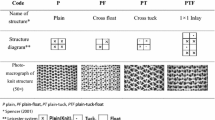Abstract
Synthetic fibers are generally produced with circular cross sectional shapes. Other cross sectional shaped fibers such as trilobal, triangular, hollow and pentagonal fibers are also produced to improve some properties of fibers and fabrics such as lustre, handle, wicking rate, strength, stiffness and bulkiness. In this research we aimed to investigate compressional behaviours of fabrics knitted from polypropylene fibers having three different cross sectional shapes; namely circular, trilobal and triangular. Morphological, structural and mechanical properties of produced fibers were evaluated by using scanning electron microscopy, X-ray diffractometry, differential scanning calorimetry and tensile tester, respectively. In terms of structural and mechanical properties, no significant differences were found related to fiber cross sectional shapes. Then, plain knitted farbrics were produced and compressional properties of these fabrics were investigated. Fabrics knitted from trilobal fibers showed the highest compressibility properties and it is followed by fabrics which are produced from triangular and circular fibers.
Similar content being viewed by others
References
A. W. Engelhardt, Int. Fiber J., 25, 4 (2011).
H. Saidi, R. Abd.aziz, H. Hassan, and A. Arifin, Sem. Penyelidikan Fak. Kej. Kimia & Kej. Sumber Asli, 3 (1993).
T. Nakajima, K. Kajiwara, and J. E. Mclntyre, “Advanced Fiber Spinning Technology”, 1st ed., pp.115–129, Woodhead Publishing, Cambridge, 1994.
Z. K. Walczak, “Processes of Fiber Formation”, 1st ed., pp.375–376, Elsiever Science Limited, 2002.
M. Lewin, “Handbook of Fiber Chemistry”, 3rd ed., p.20, CRC Press, Boca Raton, 2007.
S. Kara, MSc Dissertation, Dokuz Eylul Univ. Grad. Sch. Natur. and Appl. Sci., Izmir, Turkey, 2011.
K. I. Shin, S. H. Kim, and J. J. Kim, Fibers. Polym., 6, 82 (2005).
E. Karaca and F. Ozcelik, J. Appl. Polym. Sci., 103, 2615 (2007).
M. M. B. Hasan, V. Dutschk, H. Brünig, E. Mader, L. Haussler, R. Hassler, C. Cherif, and G. Heinrich, J. Appl. Polym. Sci., 111, 805 (2009).
B. Das, A. Das, V. K. Kothari, R. Fanguiero, and M. Araújo, Fiber. Polym., 9, 225 (2008).
N. Wang, A. Zha, and J. Wang, Fiber. Polym., 9, 97 (2008).
M. A. Bueno, A. P. Aneja, and M. Renner, J. Mater. Sci., 39, 557 (2004).
L. M. Petrick, D. N. Hild, and S. K. Obendorf, Text. Res. J., 76, 253 (2006).
M. Tascan and E. A. Vaughn, J. Eng. Fibers. Fab., 3, 32 (2008).
J. E. Mclntyre, “Synthetic Fibers: Nylon, Polyester, Acrylic, Polyolefin”, 1st ed., pp.235–287, Woodhead Publishing Limited, Cambridge, 2005.
A. Majumdar and S. S. Saha, J. Text. Ins., 99, 359 (2008).
M. Bakhtiari, S. S. Najar, S. M. Etrati, and Z. K. Toosi, Fiber. Polym., 7, 295 (2006).
S. Debnath and M. Madhusoothanan, J. Eng. Fibers. Fab., 4, 14 (2009).
ISO Standard, 11357-3, 1999.
ASTM Standard, D3822-0, 2007.
W. E. Morton and J. W. S. Hearle, “Physical Properties of Textile Fibers”, 4th ed., pp.414–420, CRC Press, New York, 2008.
J. T. McClave and Terry Sincich, “Statistics”, 8th ed., pp.435–494, Printice Hall Inc., New Jersey, 2000.
Joint Committee on Powder Diffraction Standards (JCPDS Standard), 00-050-2397.
N. Erdem, A. Cireli, and U. H. Erdogan, J. Appl. Polym. Sci., 111, 2085 (2009).
B. Kalantari, R. S. Rahbar, M. R. M. Mojtahedi, S. A. M. Shoushtari, and A. Khosroshahi, J. Appl. Polym. Sci., 105, 2287 (2007).
Author information
Authors and Affiliations
Corresponding author
Rights and permissions
About this article
Cite this article
Kara, S., Erdogan, U.H. & Erdem, N. Effect of polypropylene fiber cross sectional shapes on some structural/mechanical fiber properties and compressibility behaviour of plain knitted fabrics. Fibers Polym 13, 790–794 (2012). https://doi.org/10.1007/s12221-012-0790-8
Received:
Revised:
Accepted:
Published:
Issue Date:
DOI: https://doi.org/10.1007/s12221-012-0790-8



